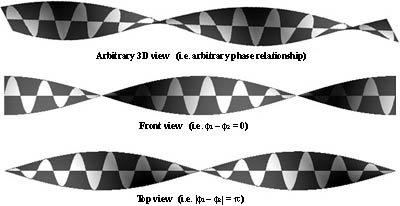2D modulated signals are seen as deriving from
the linear addition of 2D sines. In the simplest case this would be a signal
with fluctuating amplitude, resulting from the linear addition of two sines with slightly different frequencies.
For
any such addition to be meaningful, all variables represented by each signal must share
the same units. For 2D signals, these variables are:
- time (usually on the x axis),
- oscillating displacement, voltage, pressure, etc.;
(usually on the y axis), and
- some representation of the oscillation energy,
(i.e. the area outlined by the signal and the time axis).
In all cases, only two of the variables have
consistent units within a single 2D coordinate system, with relative energy values being
usually misrepresented. Additionally, the mathematical expression describing a
beating tone-pair indicates that the modulating amplitude will alternate periodically
between positive and negative values, an alteration that the 2D signals do
not represent.


